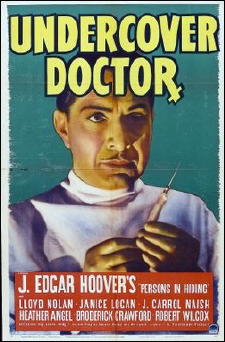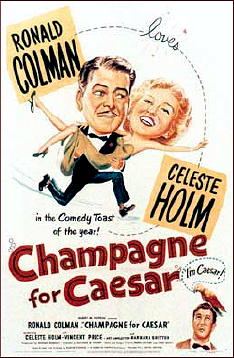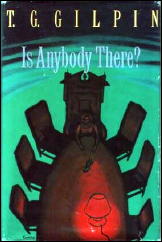June 2011
Monthly Archive
Sat 25 Jun 2011
Posted by Steve under
Reviews[5] Comments
THE BACKWARD REVIEWER
William F. Deeck
SHELLEY SMITH – He Died of Murder! Harper & Brothers, hardcover, 1948. First published in the UK: Collins, hardcover, 1947.
When the Master of The Seekers, a religious sect devoted to celibacy, truth-telling, and a vegetarian diet, is murdered, it appears to be something of a miracle, in the nonreligious sense, to be sure. The Master was shot almost point blank in the middle of a plowed field with several of his sect more or less observing. Yet no one was near him and there were no footprints other than his in the field.
Staying at the Sanctuary, the home of The Seekers, Detective Inspector Chaos of Scotland Yard investigates these now ostensibly unworldly people and their definitely worldly neighbors. A man of insights and practical knowledge, Chaos, belying his name, finds an unspiritual motive and calmly tracks down the murderer.
Generally I find novels of alleged psychological suspense tedious or unpersuasive. I have heretofore avoided Smith’s works for that reason. But this is also a detective novel, with Chaos a delightful character. Even the child whom he befriends and who intends to marry him is acceptable, most unusual in a genre where children are little horrors whether the author intended it or not.
— From The MYSTERY FANcier, Vol. 12, No. 3, Summer 1990.
Bibliographic Notes: Shelley Smith was the pseudonym of Nancy Bodington, 1912-1998, author under this pen name of 15 crime and detective novels between 1942 and 1978. There was one earlier case adventure for Inspector Jacob Chaos, that being Background for Murder (Swan, 1942; no US edition).
Fri 24 Jun 2011
UNDERCOVER DOCTOR. Paramount Pictures, 1939. Lloyd Nolan, Janice Logan, J. Carrol Naish, Heather Angel, Broderick Crawford, John Eldredge, Raymond Hatton, Paul Fix, Richard Denning. One of four short films made in 1939-40 based on the book Persons in Hiding), by J. Edgar Hoover. Director: Louis King.
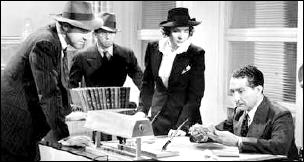
Lloyd Nolan gets top billing, although at least fifteen minutes have gone by before he shows up on the screen. (It pays to have a good agent.)
It’s J. Carroll Naish as the titular doctor instead who gets most of the screen time, he along with semi-brutish Broderick Crawford, whom I’ve never seen so young, as Public Enemy #1, Eddie Krator, a role he was (as they say) born to play.
You might get the idea from the title that Dr. Bartley Morgan (Naish) is working undercover for the FBI, for whom Nolan is of their top agents, but if so, you would be wrong. The title of this film really ought to be Underworld Doctor, since Morgan, in a moment of weakness (and the love of money) works for Krator and not against him.
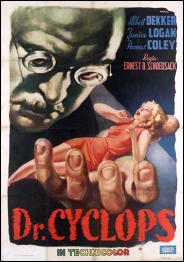
He’s a high society kind of guy, or so are his aspirations. Loving him in vain is his nurse and devoted assistant (and keeper, if truth be known), played by Janice Logan, whom you may also have seen in Dr. Cyclops (1940) as Dr. Mary Robinson. If you missed that one, you probably missed her career, as she was in only six feature films in all. At times and at the right angles, she reminded me of a slightly prettier Veda Ann Borg.
In any case, if Dr. Morgan is content to ignore the woman who works for him, aiming for a society marriage instead, it is cool Lloyd Nolan who was never loath to pass up a chance like this. Dumping Krator when his usefulness is up, Morgan suddenly finds himself short of funds and has to do one more job for his former mentor. Which is when the bottom falls out of his life, which I hope does not reveal anything I should not. (I do not believe so.)
The movie’s a solid piece of work all the way through, even though you will see all of the twists coming a mile away. You will also see lots of lots of familiar faces. I’ve listed some of them that I could put a name to, but there are many others that I couldn’t, and so I didn’t.
Fri 24 Jun 2011
Posted by Steve under
Reviews[4] Comments
REVIEWED BY DAN STUMPF:
ROBERT BLOCH – Terror. Belmont L92-537, paperback original, May 1962.
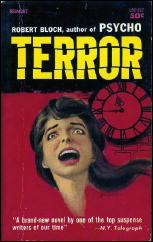
Bloch’s mysteries aren’t really much as mysteries go, I guess: his idea of plot development is to have weird characters keep dropping in on the hero and move him from place to place, scattering clues and filling in the background.
And these characters are nothing remarkable, either: tough cops, mysterious beauties, and verbose experts in arcane lore show up pretty much on cue and go through their paces. But there’s something so seamlessly easy-going about Bloch’s plotting and prose I find myself swallowing it whole.
Terror spins the tale of a nice young man thrust into a Maltese-Falcon-like hunt for a stolen artifact that devolves into a series of ritual murders committed by some death-worshiping fanatic who… well, you get the idea.
As I say, the plot consists of nothing more than our hero being picked up by various supporting players and hustled about from chapter to chapter till we reach the end. And as I say, it’s fast and fun the whole way, a style of writing that seems to have just about disappeared.
Fri 24 Jun 2011
REVIEWED BY WALTER ALBERT:
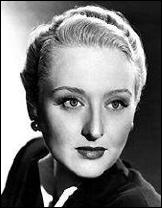
CHAMPAGNE FOR CAESAR. United Artists, 1950. Ronald Colman, Vincent Price, Celeste Holm, Barbara Brittton, Art Linkletter, Byron Foulger, Ellye Marshall, LyleTalbot, John Eldridge, Vicki Raaf, Bess Flowers; Gabriel Heatter and George Fisher as themselves. Screenplay by Hans Jacoby and Fred Brady; music by Dimitri Tiomkin. Director: Richard Whorf. Shown at Cinecon 44, Hollywood CA, Aug-Sept 2008.
Finally, an authentic star was showcased, the elegant Celeste Holm, playing a vamp (“Flame O’Neill”) who’s hired to distract genius TV quiz contestant Ronald Colman (“Beauregard Bottomley”) so that he will flub the answer to the final multi-million question that will bring down the skin lotion empire of a nutty magnate, played with hilarious and movie-stealing effect by the incomparable Vincent Price.
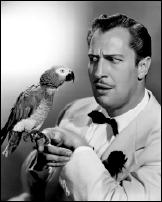
This the kind of film you don’t see much of anymore, a comedy for adults, and one whose subjects are still relevant, corporate greed and inane TV shows. Art Linkletter is perfectly cast as the TV show host (in an engaging and sympathetic performance), and every performer is pitch-perfect, down to Beauregard’s pet parrot, voiced by the great Mel Blanc.
After the screening, Holm arrived in a wheelchair, and was interviewed, with her much younger husband (maybe 40 years younger) in close attendance. She seemed frail but occasionally her voice became stronger, although she had to be constantly prompted by her husband, who filled in the details she was unable to remember.
Later, my brother and I, having lunch next door at a restaurant, saw her wheeled in and she passed by our table, impeccably made up, her skin extraordinary youthful looking.
Thu 23 Jun 2011
Posted by Steve under
Reviews[7] Comments
Unlocking the Mystery of the Hard-Boiled Heart:
Dashiell Hammett’s The Glass Key
A Review by Curt J. Evans
DASHIELL HAMMETT – The Glass Key. Alfred A. Knopf, hardcover, 1931. Reprinted many times, in both hardcover and soft. Film: Paramount, 1935 (George Raft, Edward Arnold, Claire Dodd); also: Paramount, 1942 (Alan Ladd, Brian Donlevy, Veronica Lake).
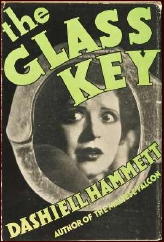
Having complained in an earlier article here on Mystery*File about the lack of analysis of Dashiell Hammett’s The Glass Key in Leonard Cassuto’s Hard-Boiled Sentimentality, I thought I would test the novel along the thematic lines suggested by Cassuto’s book. How “sentimental†is this landmark of hard-boiled crime fiction?
Cassuto’s omission of a discussion of The Glass Key is a notable one. Many eminent crime novel critics, such as Julian Symons and Tom Nolan, consider The Glass Key to be Dashiell Hammett’s greatest masterpiece, even more significant than The Maltese Falcon.
“The Glass Key is the peak of Hammett’s achievement, which is to say the peak of the crime writer’s art in the twentieth century,†declared Symons in his classic genre survey, Bloody Murder, in 1972. The Glass Key “stands out as arguably [Hammett’s] masterpiece and certainly as one of the high points of American crime fiction,†echoed Tom Nolan nearly thirty-five years later (Wall Street Journal, 15-16 April 2006, p.16).
The Glass Key probably is my favorite among Hammett’s novels, though I admit that I prefer the novels of Raymond Chandler (though conversely I prefer Hammett’s short stories to Chandler’s). Admittedly, Hammett’s narrative style, with its relentless focus on externals, is a notable achievement. Here is a representative passage, detailing the actions of Hammett’s “fixer†protagonist, Ned Beaumont:
He put the cigar on the edge of the table with nervous fingers. He put the messages away once more and leaned back in his chair, staring at the ceiling and biting a fingernail. He ran fingers through his hair. He put the end of a finger between his collar and his neck. He sat up and took the envelopes out of his pocket again, but put them back without having looked at them. He chewed his lower lip. Finally he shook himself impatiently and began to read the rest of his mail. He was reading it when the telephone bell rang.
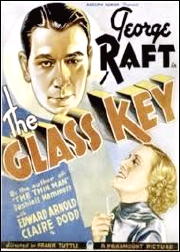
Some writers might have written, “Ned Beaumont showed signs of agitation,†and left it at that. Not Hammett! He shows you those signs of agitation; he tells you all about them. If you want know what is going on in Beaumont’s brain, however, you must go solely by those very external physical manifestations; this is all Hammett provides you.
It is an impressively maintained narrative style, but I personally prefer Chandler’s narrations, where his detective-knight tells everything he is thinking (or, at least, all he is aware that he is thinking).
As Mike Nevins has noted in 1001 Midnights, given Hammett’s emotionally opaque narrative style, the reader faces a greater challenge interpreting motivations, not merely of supporting characters, but of the enigmatic central figure, Ned Beaumont.
I trust most people know the basic story of The Glass Key. Paul Madvig, an urban political boss, has thrown in his lot with the aristocratic Henry family. This family consists of the father, a senator (whose political campaign Madvig is backing), the lovely daughter, Janet (with whom Madvig is deeply enamored) and the simply stinkeroo son, Taylor (a decadent who evidently is debauching Madvig’s daughter Opal).
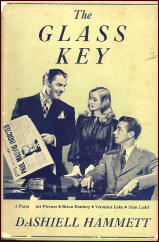
Beaumont, Madvig’s rather brighter friend and his right-hand (left-hand?) man, warns Madvig that involvement with the Henrys will just lead to trouble: “That’s why I’m warning you to sew your shirt on when you go to see them, or you’ll come away without it, because to them you’re a lower form of animal life and none of the rules apply.†(This is a beautifully written sentence, by the way. I hope it was used in the film adaptations.)
When Taylor Henry is found — by Beaumont — dead in the street, a victim of violence, a net gradually starts tightening around Madvig, as he seems increasingly implicated in the dread deed and political opponents are striving to take advantage of his vulnerability (those copious anonymous letters accusing him of murder do not help). Beaumont sticks his nose in, for reasons of practicality, personal honor and friendship.
One of the suspects in the Taylor Henry murder is a bookie named Despain, who has welched on a big payoff owed to Beaumont. So admittedly there is a practical pecuniary reason for Beaumont involving himself in the affair. But there is more to it than that, as Ned himself states to Madvig:
“Do you expect me to stumble over corpses without batting an eye?…But forget that. That doesn’t count now. This does. I’ve got to get this guy. I’ve got to.. .Listen, Paul, it’s not only the money, though thirty-two hundred is a lot, but it would be the same if it was five bucks. I go two months without winning a bet and that gets me down. What good am I if my luck’s down? Then I cop, or think I do, and I’m all right again. I can take my tail out from my legs and feel that I’m a person again and not just something that’s being kicked around. The money’s important enough, but it’s not the real thing. It’s what losing and losing and losing does to me… And then, when I think I’ve worn out the jinx, this guy takes a Mickey Finn on me. If I stand for it I’m licked, my nerves gone. I’m not going to stand for it. I’m going after him.â€
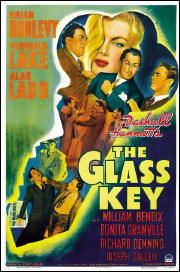
We are on a pretty spiritual level here! It is not mere money that is at stake here, then, but Beaumont’s basic worth as man.
As Madvig himself is threatened by conspiracy and circumstance, Beaumont’s motivation for playing “amateur detective†(as he himself puts it) comes to revolve around his personal friendship with Madvig. “You’re right about my being Paul’s friend,†Ned tells Janet Henry, “I’m that no matter who he killed.â€
And, sure enough, Ned memorably proves his devoted friendship throughout the novel. (He also proves the truth of his credo, “I can stand anything I’ve got to stand†— Ned has to “stand†quite a lot, including cruelly prolonged beatings.)
And here we find “sentimentality†and “empathy†in this violent hard-boiled tale filled with unpleasant people (along with Beaumont’s prolonged beatings/torture, the manual strangulation and neck breaking of another character and a ruthless psychologically induced suicide).
Raymond Chandler called The Glass Key “the record of a man’s devotion to a friend,†while critic James Sandoe observed that the novel “is quite as much an exceptionally delicate scrutiny of friendship under curious conditions as it is a detective story.â€
Throughout the novel, Beaumont suffers greatly to help his friend Madvig (ironically, one of the things he suffers is the potential loss of his friendship with Madvig). To be sure, this is “sentimentality,†but it is of the “male bonding†(or, to use modern lingo, “bromanceâ€) sort so familiar from Chandler.
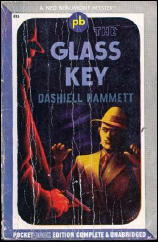
So, how do the ladies fare in The Glass Key? Pretty fair, actually!
I think we also see in the novel some of the engagement with feminine domestic sentimentality that Cassuto discusses in his book. Madvig has his own household, which includes his presumably widowed mother and his daughter Opal. Ned clearly is a part of this household as well — he effectively is a sort of adopted relation — and he is attracted by the psychic comforts it offers (he calls Opal “Snip†and Mrs. Madvig “Momâ€). So his empathy extends beyond his friend Paul to Paul’s womenfolk.
There is also the important matter of the Henry household and the fascinating character of Janet Henry (did Veronica Lake do justice to her?). Janet has a complex role in The Glass Key, combining the functions of destroying femme fatale and nurturing good girl in her one lovely self. Her relationship with Ned is left ambiguous (in my eyes) up to the last line of the novel. Such dialogue the two characters share as
“You despise me… You think I’m a whore.â€
“I don’t despise you… Whatever you’ve done you’ve paid for and been paid for and that goes for all the rest of us.â€
is not exactly the quintessence of sentimental lovers’ romance. (I cannot imagine that these sentences are uttered by Alan Ladd and Veronica Lake.) Yet clearly some sort of more sympathetic relationship between the two develops over the course of the novel.
Does the ending — foretold by Janet’s vivid nightmare of herself, Ned, the glass key and the house full of snakes — signify, as literary critic Stephen Knight contends, the withdrawal of a “semi-criminal but ultimately heroic figure [Beaumont]…from crime [Madvig] into tentative romance [Janet]â€? Hammett deliberately leaves us hanging.
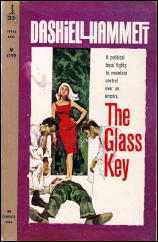
Some critics have argued that Ned’s real love relationship in The Glass Key is not with Janet but rather with his great friend Paul, i.e., that Beaumont has latent homosexual feelings for Madvig. The ambiguous last line of the novel could be read as supporting that reading, as could this frustratingly uncompleted query from Madvig to Beaumont during the two men’s climactic argument:
“What is it, Ned? Do you want her yourself, or is it–†He broke off contemptuously. “It doesn’t make any difference.†He jerked a thumb carelessly at the door. “Get out, you heel, this is the kiss-off.â€
Was Madvig going to accuse Beaumont of harboring “unnatural†feelings for him? Would his question, completed, have been something like, “Do you want her yourself or is it that you’re jealous of her?â€
Do we have an unusual love triangle here? Or are such questions — which come up concerning Chandler’s work as well — merely reflective of modern-day sociocultural perceptions, imposed on writing of the past? I do not have the definitive answer — I do not see how there can be one — but I do love this exchange between Beaumont and Madvig:
Ned Beaumont nodded. He was looking at the blond man’s outstretched crossed ankles. He said: “You oughtn’t to wear silk socks with tweeds.â€
Madvig raised a leg straight out to look at the ankle. “No? I like the feel of silk.â€
“Then lay off tweeds. Taylor Henry buried?â€
Class commentary (Madvig is a parvenu who does not fit in with his new aristocratic circle) or homosexual subtext? Let the reader decide!
However, whatever the exact nature of Ned’s and Paul’s relationship, male camaraderie and honor among men undeniably are key concerns of The Glass Key, as is true of many of the Chandler novels, which also have been assiduously mined for gay subtext.
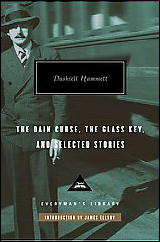
(I am not even addressing the matter of the sadistic, apish bruiser Jeff, who seems to get an erotic thrill out of beating Ned — a phenomenon much commented on by film critics in relation to the 1942 film adaptation of The Glass Key, which starred diminutive pretty boy Alan Ladd as Ned and hulking William Bendix as a memorably twisted Jeff).
As my comment above demonstrates, The Glass Key also can be (and has been) analyzed for its attitudes about American class and social structure. Hammett makes his own distaste for “the aristocracy†manifest throughout the novel and one could attribute much of Ned Beaumont’s attitudes and actions to this. Indeed, the solution to the mystery in my view is predictable to anyone sufficiently familiar with Hammett’s political beliefs.
For me, the theme of this novel can best be summed up as the struggle of a man to behave with a semblance of honor in a grievously corrupted world (see those snakes in Janet Henry’s glass key dream). Attitudes about domestic sentimentality are an aspect of this novel, but not the central concern. To be sure, however, there is much that can be debated.
The Glass Key has been praised as Hammett’s best formal mystery novel and it may well be that; but I think the mechanics of the puzzle itself really are of comparatively minor interest.
Tellingly, in a typical detective novel of the period the “glass key†of the title would refer to an actual physical object (perhaps a key used to gain entrance to Taylor Henry’s and Opal Madvig’s assignation place); but in Hammett’s tale, this key is a metaphorical symbol.
Yes, there is some discussion about a hat and a walking stick and anonymous letters and a typewriter and Beaumont in his role of amateur detective makes some whopping big intuitions about the behavior of a couple of people; yet most of the story’s interest in my view lies in its tough tone, its urban realism and, most of all, its allusive characters.
In short, the really fascinating mystery in The Glass Key is less the matter of whodunit than it is just what makes this group of fallen people tick.
Mon 20 Jun 2011
ANNA LEE: HEADCASE. ITV; UK. Made-for-TV movie, 10 January 1993. Pilot for the 5 episode series Anna Lee, 1994. Based on the novel Headcase by Liza Cody. Imogen Stubbs (Anna Lee), Alan Howard, Michael Bryant, Barbara Leigh-Hunt, Ken Stott, Kate Beckinsale. Director: Colin Bucksey.

I’ve not yet watched any of the five episodes of the series that followed, but in my opinion it got off to a good start. I understand that Liza Cody was unhappy with it, however, so maybe there was a hitch somewhere between this two-hour film (including commercials) and what followed. Having somehow lost control of her own character, Cody even decided to stop using fledgling PI Anna Lee as a character and switched to writing her Eva Wylie series of novels instead.
But this introductory episode is a good one, and if it ever passes by your way, in my opinion you ought to snap it up. Anna Lee is a fledgling private eye in this one, having abandoned the police force due to her ambivalence toward regimentation and following orders. She doesn’t try to make a go of it on her own, however. She takes a job with an investigative firm headed up by Commander Brierly (Michael Bryant), a no-nonsense type who nonetheless seems to take a shine to Anna, even though the rest of the staff seems to stay rather cool toward her.
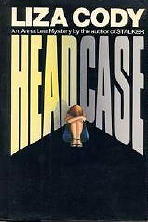
It may be because of her age, as well as her difficulty in showing up to work on time, phoning in, and all of the other office rules. It’s not clear how old Anna Lee is, but Imogen Stubbs, who plays her, was only 32 at the time, and she looks much much younger, especially when she comes in to work the first day in a mini-skirt and flowing strawberry blonde hair.
What she had expected was only a small duty as an undercover security agent in a record shop. Instead the Commander assigns her to another case, that of a missing daughter, a girl in her early 20s perhaps, but a sensitive one whose family had closely guarded over her. An easy case, the Commander thinks, but naturally there’s more to it than that. Once found, her memory’s confused and she’s kept sedated in a nursing home, unable to explain where she had been and what she’d been doing.
Thea Hahn, it seems, played to perfection by the ethereally frail Kate Beckinsale, was seen in a coastal hotel the night a man’s body was found the next day in his room. There are more suspects than Thea, but what Anna’s task is now is to protect her while she cannot protect herself.

Which makes for a most interesting and entertaining case for her first outing, with sex – casual, real and imagined – the key to many of the characters’ motives. The only flaw, if one there is, is that it is not all that difficult for the viewer, taking a relaxed pace, to separate the red herrings from the actual trail of events, as they happen.
And as the case goes on, and as Anna pulls the facts together, she also begins to dress more appropriately – and act more and more professionally – as the story goes on. In both regards, the Commander stolidly and (as far as I can tell) enthusiastically approves.
Mon 20 Jun 2011
REVIEWED BY MICHAEL SHONK:
CLIFFHANGERS! NBC-TV. February 27, 1979 through May 1, 1979. Created by Kenneth Johnson. (I was unable to visually confirm other on-screen credits.)
THIS WEEK’S REVIEW:
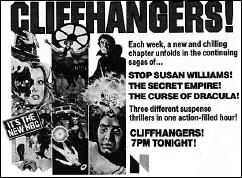
STOP SUSAN WILLIAMS. 20 minute Chapters. Cast: Susan Anton as Susan Williams, Michael Swan as Jack Schoengarth, Ray Walston as Bob Richards, Albert Paulsen as Anthony Korf.
Could the old movie serials succeed on network television in 1979? Can you do three different series for one hour program on one budget? What about Cliffhangers’ other two serials? Will science fiction western The Secret Empire, and horror Curse of Dracula remain forgotten? And what truly evil deed was NBC responsible for that left millions searching for answers? For the answer to some of these questions and more, keep reading!
Stop Susan Williams was a “twelve” chapter serial, that started with Chapter Two (there was no Chapter One). Susan was a talented photographer for the New York “Dispatch”. Convinced her brother’s death was murder, she travels the globe in search of his killer. Susan stumbles across the evil conspiracy behind her brother’s death. It is up to Susan and her friends to save the world before May 15th.
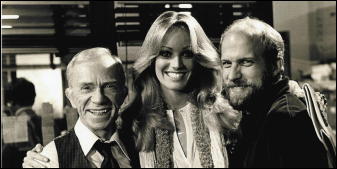
The series recreated the old cliffhanger style and successfully captured the appeal of the old serials. Susan would weekly escape from such dangers as being pushed out a high-rise apartment window, a snake in the bath, trapped in a pit with a lion and piranhas nipping at her heels.
But the attempts to update the old movie serial to 1970s failed. The mercenary “hero” was more a weak Sam Spade than the popular true blue serial good guy with his strong yet simple moral code. The 1970s style dialog was cluttered with lame banter that was more irritating than fun.
Susan Anton did well as the likable heroine. The announcer (probably Paul Frees) was perfect. But the rest of the cast was trapped in one-dimensional characters and a plot more interested in the cliffhangers than the story. Just like the old movie serials.
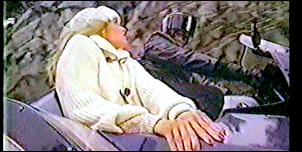
It is no spoiler that Susan saves the world, but she failed to stop one evil villain’s plans. NBC scheduled Cliffhangers, with its nostalgic appeal, opposite ratings powerhouses with nostalgic appeal, Happy Days and Laverne & Shirley.
But evil NBC was not done. The network (boo! hiss!) canceled Cliffhangers and took Stop Susan Williams off the air before the final Chapter could air. NBC not only stopped Susan Williams, it ended the adventure with the good guys trapped in a mine, the villains celebrating, and the world facing certain doom!
But all was not lost! Stop Susan Williams, including the unseen final chapter, was edited into a TV-Movie titled The Girl Who Saved the World (1979). Finally the happy ending was revealed, leaving NBC foiled again.
For this review, I watched all of the chapters including the final chapter at YouTube. The picture quality is poor and the credits have been edited out, but if you enjoy the old movie serials, the YouTube copy is worth watching. Watch for a graphics blooper, when they lose count and number Chapter 6 as Chapter 7. The chapter titles follow:

Chapter 2 “The Silent Enemy”
Chapter 3 “Jungle Death Trap”
Chapter 4 “Thundering Doom”
Chapter 5 “Deadly Descent”
Chapter 6 “Watery Grave”
Chapter 7 “Cauldron of Fire”
Chapter 8 “River of Blood”
Chapter 9 “Wheels of Destruction”
Chapter 10 “Terror From the Sky”
Chapter 11 “The Villain Revealed”
Chapter 12 “Crypt of Disaster”
Sun 19 Jun 2011
Posted by Steve under
ReviewsNo Comments
IT IS PURELY MY OPINION
Reviews by L. J. Roberts
MARTIN WALKER – Black Diamond. Quercus, UK, hardcover, 2010. Alfred A. Knopf, US, hardcover, August 2011.
Genre: Police Procedural. Leading character: Bruno Courréges; 3rd in series. Setting: France.
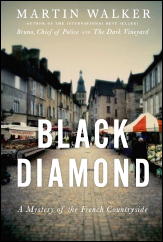
First Sentence: There weren’t many times that Bruno Courréges disliked his job, but today was one of them.
Truffles are big business in France. When it is suspected that someone is replacing high-quality truffles with cheaper Chinese truffles, Bruno is asked to do an informal investigation. With a heinous murder and attacks on Vietnamese merchants, things become serious, and dangerous, very quickly.
Any impression that this was is light, cozy series, is completely dispelled by this book. It is, in fact, a strong, complex, compelling police procedural with a protagonist who has become one of my favorites.
Although Bruno is the focal character, it is his relationships with friends and associates that add layers and texture. Bruno is his town’s only policeman. This makes him an integral part of the community while helping maintain its structure.
He is intelligent,analytical and a by-the book policeman without being rigid. He has a history, doesn’t shy from violence, dresses as Pare Noel and teaches rugby and tennis to the kids. In other words, he is well rounded, interesting and realistic.
Walker, with a deft hand, starts with bucolic descriptions which set the scene and provide sense of place. Throughout there are mouth-watering descriptions of food and its part in a tradition which touches the heart. The use of French expressions lends veracity while their translation prevents readers from feeling excluded.
The plot builds and weaves in a way that kept me going. It started off seemingly simple, yet escalated quickly as does the motive behind the crimes. Again, anything but a cozy; yet an interesting look into the politics and issues of France; one of the reasons I am attracted to books set outside the US.
As always, I recommend starting the series at the beginning and not being put off by either the title or cover of the first book, Bruno, Chief of Police. Walker is a very good writer; Bruno a very good policeman in a series that improves with each entry.
Rating: Very Good.
Previously reviewed by LJ on this blog:
MARTIN WALKER – The Dark Vineyard.
Sat 18 Jun 2011
Posted by Steve under
ReviewsNo Comments
A REVIEW BY RAY O’LEARY:
M. V. HEBERDEN – Murder of a Stuffed Shirt. Doubleday Crime Club, hardcover, 1944.
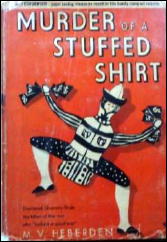
Desmond Shannon, a big redheaded PI in the Mike Shayne mode, gets back to his New York office after doing some Intelligence Work during World War II and suddenly finds himself a very popular fellow: Wealthy Theodore Armisted has just been murdered, after tipping the FBI off about an organized Draft Evasion Ring. The FBI and local Police want Shannon in on the case, and so do Armisted’s surviving relatives, who hire him to investigate.
Problem is, one of the suspects saved Shannon’s life years ago in South America, and Shannon is determined that, guilty or innocent, he will not be charged with the crime… Which is gonna call for some astute detective work on his part or some tricky writing on Heberden’s.
Due to the wartime paper shortage, this was published in a hardback edition barely larger than a paperback, and though the title sounds like a Classical Puzzle Novel, this is actually a Hard-Boiled PI yarn. And — thanks to some snappy dialogue — a passable read.
Previously on this blog:
Mystery Woman.
Reviewed by William F. Deeck: CHARLES L. LEONARD – Deadline for Destruction.
Archived Review by Steve Lewis: CHARLES L. LEONARD – Sinister Shelter.
Sat 18 Jun 2011
REVIEWED BY BARRY GARDNER:
T. G. GILPIN – Death of a Fantasy Life. St. Martin’s, US, hardcover, 1993. First published in the UK: Quartet, hardcover, 1988.
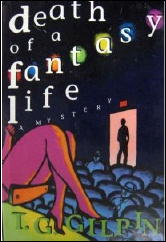
I reviewed what I thought was Gilpin’s first novel, Is Anybody There?, for Mystery News, and thought it was a very good and off-beat story. But it turns out that this was his first, published in England in 1988 and only now appearing here.
Speaking of unlikely teams, how about a professor of theoretical linguistics and a Soho stripper? The professor comes to town seeking an erratic and unlovable nephew of whom he is the guardian, and while having a pint in a pub meets a stripper when she mistakes him for someone else.
One of her friends has been murdered a short time before, and it turns out that the erratic nephew knew her; as is true of the next stripper who is murdered, very quickly.
The prof and the stripper get their heads together, he out of concern for the nephew, she for the sorority of strippers, but they come to no conclusions, and the alliance dies aborning when the somewhat sexless prof rebuffs her friendly (no more, surely) advances.
He is unable to settle back into his routine, however, and when certain events occur he is drawn back in to the world well lost.
This is one of those books of a peculiarly British type; not farcical, but with a cast of characters just slightly askew. It’s not humorous in a thigh-slapping sense, but somehow the overall tone is one of gentle humor.
Gilpin is a literate and enjoyable stylist who seems to like the people about whom he writes, and I think you will, too. This doesn’t have the depth of Is Anyone There?, but it’s defintely worth reading. I particularly liked the ending.
— Reprinted from Ah, Sweet Mysteries #7, May 1993.
Bibliography: Adapted from the Revised Crime Fiction IV, by Allen J. Hubin —
GILPIN, T(imothy) G., 1946- .
Death of a Fantasy Life (n.) Quartet 1988; St. Martin’s, 1993.
Is Anybody There? (n.) Constable 1991; St. Martin’s, 1992.
Missing Daisy (n.) Constable 1995; St. Martin’s, 1995
« Previous Page — Next Page »


